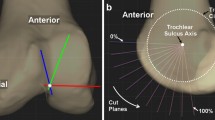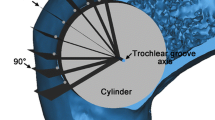Abstract
Purpose
An unnatural design of the sagittal geometry of the femoral trochlea may cause abnormal patellofemoral kinematics and complications after knee arthroplasty. Most previous studies examined the sagittal curvature of the femoral trochlea on 2D parasagittal planes, which may not represent the true sagittal curvature of the complex 3D femoral trochlea.
Methods
The current study evaluated the sagittal geometry of the femoral trochlea of 100 healthy Chinese subjects (50 women and 50 men) with 3D analysis. A close-fit sphere was generated on the surface of the medial and lateral trochlear articular surface, respectively. The radii of the spheres represented the sagittal radii of the femoral trochlear sagittal curvature. A cylinder was then established and its radius was adjusted to allow the deepest points of the curved trochlear groove touching the cylindrical surface. The radius of the cylinder represented the sagittal radius of the trochlear groove.
Results
In the men, the average radii of the curvature of the femoral trochlea were 18.8 ± 2.5 mm and 25.5 ± 2.8 mm for the medial and lateral femoral trochleas, respectively. In the women, the average radii of the curvature of the femoral trochlea were 20.2 ± 3.0 mm and 26.6 ± 2.7 mm for the medial and lateral femoral trochleas, respectively. The average radius of the cylinder of the trochlea groove was 19.6 ± 2.0 mm with a circular arc of 123.2° ± 13.0° in the men. In the women, the radius was 20.2 ± 1.7 mm with a circular arc of 127.9° ± 11.7°.
Conclusion
The present study provided a reliable and consistent assessment of the sagittal geometry of the femoral trochlea in the Chinese population. The results of the current study may be helpful to improve the understanding of the knee kinematics and develop the physiological knee prostheses.





Similar content being viewed by others
References
Amis AA (2007) Current concepts on anatomy and biomechanics of patellar stability. Sports Med Arthrosc 15:48–56
Baldini A, Anderson JA, Cerulli-Mariani P, Kalyvas J, Pavlov H, Sculco TP (2007) Patellofemoral evaluation after total knee arthroplasty. Validation of a new weight-bearing axial radiographic view. J Bone Jt Surg Am 89:1810–1817
Barink M, van de Groes S, Verdonschot N, de Waal Malefijt M (2003) The trochlea is bilinear and oriented medially. Clin Orthop Relat Res 411:288–295
Buechel FF, Pappas MJ, Makris G (1991) Evaluation of contact stress in metal-backed patellar replacements. A predictor of survivorship. Clin Orthop Relat Res 273:190–197
Cheng FB, Ji XF, Zheng WX, Lai Y, Cheng KL, Feng JC, Li YQ (2010) Use of anthropometric data from the medial tibial and femoral condyles to design unicondylar knee prostheses in the Chinese population. Knee Surg Sports Traumatol Arthrosc 18:352–358
Conley S, Rosenberg A, Crowninshield R (2007) The female knee: anatomic variations. J Am Acad Orthop Surg 15(Suppl 1):S31–S36
D’Lima DD, Chen PC, Kester MA, Colwell CW Jr (2003) Impact of patellofemoral design on patellofemoral forces and polyethylene stresses. J Bone Jt Surg Am 85-A(Suppl 4):85–93
Elias SG, Freeman MA, Gokcay EI (1990) A correlative study of the geometry and anatomy of the distal femur. Clin Orthop Relat Res 260:98–103
Fitzpatrick CK, Baldwin MA, Ali AA, Laz PJ, Rullkoetter PJ (2011) Comparison of patellar bone strain in the natural and implanted knee during simulated deep flexion. J Orthop Res 29:232–239
Freeman MA, Samuelson KM, Elias SG, Mariorenzi LJ, Gokcay EI, Tuke M (1989) The patellofemoral joint in total knee prostheses. Design considerations. J Arthroplast 4(Suppl):S69–S74
Heinert G, Kendoff D, Preiss S, Gehrke T, Sussmann P (2011) Patellofemoral kinematics in mobile-bearing and fixed-bearing posterior stabilised total knee replacements: a cadaveric study. Knee Surg Sports Traumatol Arthrosc 19:567–572
Iranpour F, Merican AM, Baena FR, Cobb JP, Amis AA (2010) Patellofemoral joint kinematics: the circular path of the patella around the trochlear axis. J Orthop Res 28:589–594
Iranpour F, Merican AM, Dandachli W, Amis AA, Cobb JP (2010) The geometry of the trochlear groove. Clin Orthop Relat Res 468:782–788
Keblish PA, Varma AK, Greenwald AS (1994) Patellar resurfacing or retention in total knee arthroplasty. A prospective study of patients with bilateral replacements. J Bone Jt Surg Br 76:930–937
Kulkarni SK, Freeman MA, Poal-Manresa JC, Asencio JI, Rodriguez JJ (2001) The patello-femoral joint in total knee arthroplasty: is the design of the trochlea the critical factor? Knee Surg Sports Traumatol Arthrosc 9(Suppl 1):S8–S12
Kwak SD, Colman WW, Ateshian GA, Grelsamer RP, Henry JH, Mow VC (1997) Anatomy of the human patellofemoral joint articular cartilage: surface curvature analysis. J Orthop Res 15:468–472
Lonner JH (2007) Patellofemoral arthroplasty. J Am Acad Orthop Surg 15:495–506
Moreland JR, Thomas RJ, Freeman MA (1979) ICLH replacement of the knee: 1977 and 1978. Clin Orthop Relat Res 145:47–59
Moro-oka T, Matsuda S, Miura H, Nagamine R, Urabe K, Kawano T, Higaki H, Iwamoto Y (2002) Patellar tracking and patellofemoral geometry in deep knee flexion. Clin Orthop Relat Res 394:161–168
Muller W, Wirz D (2001) The patella in total knee replacement: does it matter? 750 LCS total knee replacements without resurfacing of the patella. Knee Surg Sports Traumatol Arthrosc 9(Suppl 1):S24–S26
O’Connor JJ, Shercliff TL, Biden E, Goodfellow JW (1989) The geometry of the knee in the sagittal plane. Proc Inst Mech Eng H 203:223–233
Shih YF, Bull AM, Amis AA (2004) The cartilaginous and osseous geometry of the femoral trochlear groove. Knee Surg Sports Traumatol Arthrosc 12:300–306
Siebold R, Axe J, Irrgang JJ, Li K, Tashman S, Fu FH (2010) A computerized analysis of femoral condyle radii in ACL intact and contralateral ACL reconstructed knees using 3D CT. Knee Surg Sports Traumatol Arthrosc 18:26–31
Siu D, Rudan J, Wevers HW, Griffiths P (1996) Femoral articular shape and geometry. A three-dimensional computerized analysis of the knee. J Arthroplast 11:166–173
Yue B, Varadarajan KM, Ai S, Tang T, Rubash HE, Li G (2011) Differences of knee anthropometry between Chinese and white men and women. J Arthroplast 26:124–130
Yue B, Varadarajan KM, Ai S, Tang T, Rubash HE, Li G (2011) Gender differences in the knees of Chinese population. Knee Surg Sports Traumatol Arthrosc 19:80–88
Zoghi M, Hefzy MS, Fu KC, Jackson WT (1992) A three-dimensional morphometrical study of the distal human femur. Proc Inst Mech Eng H 206:147–157
Acknowledgments
This study was supported by the Fund of Science and Technology Commission of Shanghai (09441900104/11QA1404100), Fund for Key Disciplines of Shanghai Municipal Education Commission (J50206), and National Natural Science Foundation of China (30901517).
Author information
Authors and Affiliations
Corresponding author
Additional information
Jun Wang and Bing Yue are the co-first authors.
Rights and permissions
About this article
Cite this article
Wang, J., Yue, B., Wang, Y. et al. The 3D analysis of the sagittal curvature of the femoral trochlea in the Chinese population. Knee Surg Sports Traumatol Arthrosc 20, 957–963 (2012). https://doi.org/10.1007/s00167-011-1679-6
Received:
Accepted:
Published:
Issue Date:
DOI: https://doi.org/10.1007/s00167-011-1679-6




